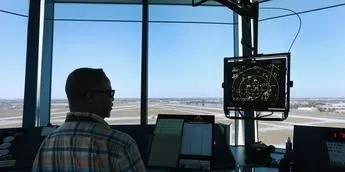
An air traffic controller working at a major Australian airport was found asleep at the end of their night shift, according to an investigation by the Australian Transport Safety Bureau (ATSB).
The worker had signed on for their shift, which ran from 10 p.m. to 6 a.m., at the Brisbane Centre, a major air traffic control center at Brisbane Airport.
Brisbane Centre monitors air traffic for most of northern Australia, and the controller found asleep was monitoring air traffic in and around Cairns, a city around 850 miles north of Brisbane.
The incident occurred on December 9, 2022, when a morning shift controller arrived at work at 5:15 a.m. to find their night shift counterpart asleep at the console.
The worker was discovered lying across two chairs with a blanket covering them, according to the report. They were still wearing their headset, and the air situation display (ASD) screensaver was on.
After ensuring there was no traffic in the area, the station was handed over to the oncoming controller.
The report noted that the Brisbane Centre building was cooler at night, and it was considered normal practice for blankets to be used during night shifts.
The ATSB's report blamed multiple night shifts in a short space of time, the worker's low workload, and an ineffective risk management system for the incident.
It noted that the worker had 10 years of experience as a controller and had been in their current position for three years. However, due to last minute roster changes, they had worked their seventh night shift in nine days and had not taken the recommended rest period in between.
A Brisbane Centre air traffic controller who was found asleep at their workstation towards the end of their shift had worked multiple consecutive night shifts resulting in sleep debt, an ATSB investigation report details.
There had been no traffic or scheduled flights in the airspace the controller was responsible for and a system supervisor had been on duty at the front desk of the center.
However, the report found that cumulative fatigue was not being effectively managed at the center.
"Likely due to an underlying lack of resources within Airservices Australia, there was an over-reliance on tactical changes to manage the roster," investigators said.
The ATSB said it would update its safety procedures and fatigue risk management regulations in response to the incident, and will continue to monitor the issue.
Airservices Australia, which runs the Brisbane Centre, said in a statement to Business Insider that it has "reviewed and updated guidance to our staff on fatigue management processes, and is working with CASA to explore further improvements on our fatigue risk management system."
Brisbane Airport, where Brisbane Centre is based, is Australia's third-busiest airport, handling around 22.6 million passengers annually. It has consistently been among the 100 busiest airports in the world and was ranked as the world's 32nd-best by Skytrax in 2024.
In the US, fatigue has been a growing safety concern as shortages of air traffic controllers have driven up the amount of overtime required for those that remain. Some controllers have turned to alcohol and sleeping pills to cope with their grueling schedules.
Last year, The New York Times found that near-misses between aircraft were happening more often than previously thought.

















Comments